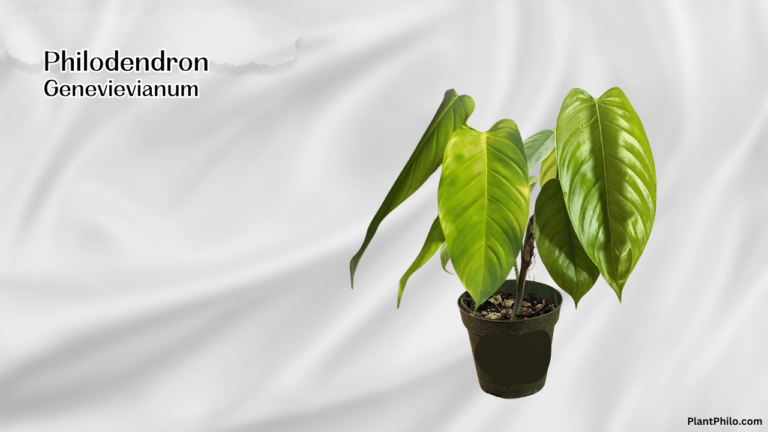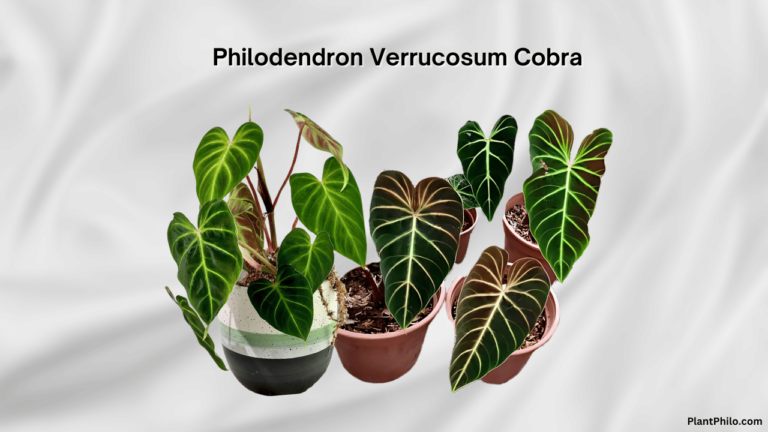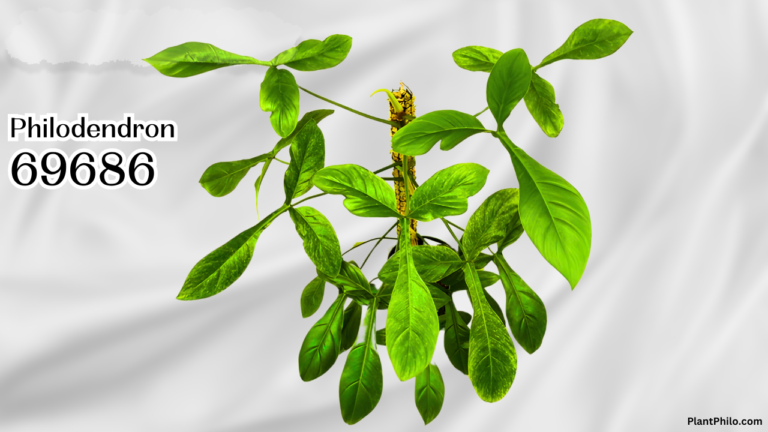Verrucosum Panther Information on Philodendron: Identification, Care, and Growth Tips
The Philodendron Verrucosum “Panther” stands out for its unique heart-shaped, velvety green leaves with vivid veins and a maroon underside. As someone who enjoys discovering special houseplants, I find this variety a great choice for anyone who wants a striking, yet manageable, plant.
Its petioles even have fine hairs, adding more interest to its look.

What makes the Verrucosum Panther even more appealing is its ability to thrive in many indoor spaces with the right care. It grows well in bright, indirect light and likes high humidity and frequent watering with fast-draining soil, making it both beautiful and rewarding to grow at home.
You can learn more details about this plant’s appearance and care on reputable sites like Gabriella Plants.
If you are looking for a resilient climbing philodendron that adds texture and color to your collection, the Verrucosum Panther is worth your attention. Its distinctive foliage and manageable care needs offer something special for all plant enthusiasts.
Key Features and Identification

The Philodendron verrucosum Panther stands out because of its unique leaf patterns, climbing nature, and bold vein design. I find that each feature is easy to notice and makes it simple to tell this variety apart from other philodendrons.
Leaf Shape and Texture
I see that the leaves of the Philodendron verrucosum Panther are large and distinctly heart-shaped. Mature leaves can reach up to 18 inches long, making them quite prominent in any indoor space.
The surface is velvety to the touch, which creates a soft look and feel. This texture also gives the leaves a slight shine under bright, indirect light.
The undersides of the leaves can be just as eye-catching. On young leaves, there may be a maroon or reddish hue that gradually fades as the plant matures.
Tiny hairs sometimes cover the stems and leaf backs, adding to the texture. According to Ken’s Philodendrons, the undersides may even show a maroon tiger pattern.
Growth Habit
Philodendron verrucosum Panther is a vining, climbing plant and thrives when I provide some type of support for its stems. It grows well on moss poles, trellises, or slabs of wood.
As a hemiepiphyte, it naturally climbs trees in the wild, which means its roots can cling tightly to rough surfaces. New growth usually emerges from the top, and older leaves drop off naturally from the lower sections.
This keeps the plant looking tidy and focused on upward growth. The plant’s growth pattern makes it an excellent choice for both hanging baskets and vertical displays, as described on the Ecuagenera product page.
Distinctive Veining
One of the most memorable characteristics is the leaf veining. The upper sides of the leaves have bright, lime-green or yellow veins that form a striking contrast against the dark, velvety green background.
These veins are thick, prominent, and arranged in a symmetrical, almost geometric pattern. This bold veining creates a “quilted” effect, which I find is often the first thing people notice about the plant.
The vein color and pattern can change slightly with light intensity and the age of the leaf. For collectors, this distinct veining is a top reason to add Philodendron verrucosum Panther to their collections, as seen in detailed care guides and online listings.
Natural Habitat and Origin

I have learned that understanding where Philodendron verrucosum ‘Panther’ comes from, and how it grows in the wild, helps me provide the best care for this unique plant. The following details highlight specific regions and conditions that shape its growth.
Native Range
Philodendron verrucosum ‘Panther’ is native to the tropical rainforests of Central and South America. I find that it is especially common in countries like Ecuador, Colombia, Costa Rica, Panama, and Peru.
These regions provide a lush, humid environment, ideal for its growth. In the wild, this philodendron thrives in the understory layer of the forest.
Trees and foliage above shield it from direct sun, creating a gentle, filtered light. The plant often grows at higher elevations, usually between 1,000 and 5,500 feet (300 to 1,700 meters) above sea level, where the air remains moist and cool.
More information about its discovery and growth in these regions can be found at Gardenia and Exotic Rainforest.
Environmental Preferences
I notice that this species prefers high humidity, usually above 60%, and consistently warm temperatures between 65°F and 80°F (18°C to 27°C). Protection from harsh sunlight is crucial, as the leaves can burn if exposed directly.
Instead, the plant flourishes with dappled or indirect light. The forest floor provides rich, well-draining soil made up of decaying plant matter, giving the roots both nutrients and good aeration.
Rainfall is frequent, helping to keep the environment moist without waterlogging the roots. Maintaining these specific conditions is key if I want to mimic the native habitat and keep the plant healthy indoors.
Care Requirements
I have found that maintaining a healthy Philodendron Verrucosum ‘Panther’ depends on careful attention to light, temperature, humidity, and the right soil mix. Consistent care in each of these areas helps prevent common problems and encourages strong, attractive growth.
Light and Temperature Needs
I always place my Verrucosum ‘Panther’ in a spot with bright, indirect light. Direct sunlight can scorch its delicate leaves, while too little light causes leggy, slow growth.
Near an east- or north-facing window works well for me since the light is bright but not harsh. This plant prefers warm temperatures.
I keep mine in an area between 68°F and 78°F for best results. Cooler temperatures can slow growth or lead to leaf damage.
I use a thermometer in my growing area to ensure it stays within this ideal range. Temperature drops at night are safe if they aren’t drastic.
I avoid putting it near vents or drafty windows because temperature fluctuations can stress the plant. Even during winter, I make sure it does not sit below 60°F for long to avoid cold stress.
For more detail on light and heat, I refer to this care guide.
Watering and Humidity
I water my Verrucosum ‘Panther’ when the top inch of soil feels dry to the touch. Letting the soil dry slightly between waterings helps prevent root rot.
I check the soil moisture by sticking my finger in rather than following a fixed schedule. This plant loves high humidity.
Levels above 60% are best. I often use a humidifier or place my plant in rooms with higher ambient moisture, like the bathroom.
If my home feels dry, I group plants together or set the pot on a tray filled with pebbles and water to raise humidity around the leaves. The leaves can brown or curl if the air stays too dry, so regular misting can also help.
Soil Preferences
When I repot or plant my Verrucosum ‘Panther’, I use a well-draining, chunky mix. A typical blend for me includes equal parts orchid bark, perlite, and high-quality potting soil.
This blend allows air to reach the roots and helps excess water drain away, preventing soggy soil. I avoid heavy soils that retain too much moisture, as the roots can easily rot if left wet for extended periods.
If I notice water pooling in the bottom of the pot after watering, I know the soil needs more drainage. Leca or chunky coco chips can also be added for extra structure.
Fertilization Practices
I fertilize my Verrucosum ‘Panther’ during the growing season, which runs from spring to early fall. I choose a balanced, water-soluble fertilizer and dilute it to half the strength recommended on the label.
I feed my plant every four weeks to encourage healthy, steady growth. During the winter months, I stop regular feeding because plant growth slows.
Over-fertilizing can damage the roots, so I always err on the side of caution. As discussed by plant hobbyists online, I find applying fertilizer at half strength every other watering is effective and safer for my plant’s sensitive roots, as noted by this user experience.
Propagation and Common Issues
I have found that Philodendron verrucosum Panther can be both rewarding and challenging to care for. Understanding the right propagation techniques, dealing with pests, and solving growth problems are key for maintaining a healthy plant.
Propagation Methods
When I propagate my Philodendron verrucosum Panther, I use stem cuttings. I make sure to cut a piece that has at least one node and a few healthy leaves.
Nodes are small bumps on the stem where roots will grow. I prefer to root cuttings in water or well-draining soil.
In water, I see roots start to form within a few weeks if I keep the cutting in a warm spot with bright, indirect light. I change the water every 3 to 5 days to prevent bacteria buildup.
Here’s a simple list of steps I follow:
- Choose a healthy stem with a visible node
- Cut below the node using clean scissors
- Place the cutting in water or moist soil
- Wait for roots to form (usually 2-4 weeks)
- Transplant to a new pot when roots are at least 2 inches long
For more specific tips on propagating, I recommend reading detailed guides on Philodendron verrucosum propagation.
Pest and Disease Management
I regularly check my plant for pests like spider mites, mealybugs, and thrips. These insects hide under the leaves and stem.
When I see small webs, white cottony spots, or deformed leaves, it’s a clear sign of trouble. I use insecticidal soap or neem oil spray for mild infestations.
For fungal issues or root rot, I avoid overwatering. Keeping the soil lightly moist but not soggy helps.
Good airflow also prevents mold and mildew on the leaves. I always use sterilized tools to avoid spreading disease, and I wipe leaves down with a damp cloth if I see dust or pests.
If I see yellow, mushy leaves, I check the roots for rot and trim away any dead parts before repotting in fresh soil.
Growth Challenges
The verrucosum Panther can be sensitive to sudden light and temperature changes. If I notice drooping or yellow leaves, it’s usually a sign of too much direct sunlight or a cold draft.
I keep my plant in a warm room with high humidity, away from vents and windows that can cause temperature swings. I mist the leaves or use a humidifier to keep the humidity above 60%.
Leggy growth or small leaves mean the plant needs more indirect light. If growth is slow, I check the soil to make sure it’s not compacted and repot if roots are crowded.
Regular pruning helps keep the plant bushy. Trimming long stems encourages new growth and keeps the plant’s shape more full, as mentioned in this care guide.
Frequently Asked Questions
I find that growing Philodendron Verrucosum Panther takes attention to light, water, humidity, and soil. Understanding its care routine and what problems it may face helps me keep it healthy year-round.
What are the ideal growing conditions for a Philodendron Verrucosum Panther?
I keep my Philodendron Verrucosum Panther in a spot with bright, indirect sunlight and away from direct beams. High humidity, around 60% or more, is important.
Temperature between 65°F to 80°F is best, as it mimics its natural environment. More details are available on growing Philodendron Verrucosum Panther.
How often should a Philodendron Verrucosum Panther be watered?
I check the top inch of soil and only water when it feels dry. Usually, this means watering once a week, but it can vary depending on how much light and heat the plant gets.
Overwatering can cause root rot, so I make sure not to let the plant sit in water.
Can a Philodendron Verrucosum Panther thrive in low-light environments?
Bright, indirect sunlight is best, and I notice that low light causes leggy stems and less vibrant leaves. While it may survive in low light for a short time, growth slows down and leaf color fades.
I always avoid direct sunlight, as it can burn the leaves. For more, see tips on light requirements.
What is the best soil mix for cultivating a Philodendron Verrucosum Panther?
I use a well-draining mix that contains peat, perlite, and orchid bark. This mix keeps the roots moist but not soggy.
Good drainage is necessary to prevent root rot. The soil should be loose enough to allow for good airflow around the roots.
How do you propagate a Philodendron Verrucosum Panther?
I usually take stem cuttings just below a node and place them in water or moist soil. Once roots have developed, I transplant the cutting to its own pot.
I keep the cutting in a warm, humid spot until new growth appears.
What are common pests or diseases that affect the Philodendron Verrucosum Panther, and how can they be treated?
I sometimes see spider mites on the leaves, which show as tiny webs or specks. Spider mites and other pests like mealybugs can be treated with insecticidal soap or by wiping the leaves with a damp cloth.
Yellowing leaves or brown edges can be signs of overwatering, low humidity, or disease. I trim affected leaves and adjust care as needed. Learn about common pests and problems linked to this plant.



